
Original Link: https://www.anandtech.com/show/6807/bitfenix-raider-case-review-all-these-little-things
BitFenix Raider Case Review: All These Little Things
by Dustin Sklavos on February 28, 2013 12:01 PM EST- Posted in
- Cases/Cooling/PSUs
- bitfenix
- ATX
.jpg)
Introducing the BitFenix Raider
BitFenix has historically been fairly reliable at producing reasonably priced cases that have their own aesthetic flair and solid performance. They've been exactly daring enough with designs like the extremely popular Prodigy, and been able to produce great value with less expensive builds like the Merc series. For the most part their midrange has been fairly well-covered by the Shinobi, but for users looking for something with a little more pep and a little different design, today we have on hand the Raider.
The Raider seems like a fairly basic ATX mid-tower, but there's some secret sauce at work here. BitFenix includes a pseudo-removable drive cage and, almost surprisingly, no side ventilation. No window, no side fan, nothing but two solid side panels. There's also a trio of BitFenix's silent Spectre fans, and that signature attractive soft-touch plastic finish. It sounds like the Raider has a lot going for it, but does it hold up?
.jpg)
If you've been keeping track of the case reviews here, the Raider will in many ways seem like it's keeping up with the state of the art of case design. BitFenix has a mostly removable drive cage (more on this later), a recessed cabling channel in the motherboard tray, four USB 3.0 ports, and healthy headroom for radiators in the top of the enclosure. There's even my much beloved fan controller standard, though I'll admit a fan controller is much less exciting when it's paired with low noise fans in the first place (as is also true of Nanoxia's Deep Silence cases.) The ideal circumstance for one is to fine tune high performance fans.
Despite being a very feature rich case, though, testing of the BitFenix Raider revealed a design that feels strangely half-baked. This is by no means a bad enclosure and it can almost justify itself entirely on its fairly attractive aesthetic (at least I think so), but as they say, the devil is in the details, and there are a lot of details that it seems like BitFenix's designers may have missed.
| BitFenix Raider Specifications | ||
| Motherboard Form Factor | Mini-ITX, Micro-ATX, ATX | |
| Drive Bays | External | 4x 5.25" |
| Internal | 6x 2.5"/3.5", 1x 2.5" | |
| Cooling | Front | 2x 120mm intake fan (supports 1x 200mm) |
| Rear | 1x 120mm exhaust fan | |
| Top | 1x 200mm fan mount | |
| Side | - | |
| Bottom | 1x 120mm fan mount | |
| Expansion Slots | 7 | |
| I/O Port | 4x USB 3.0, 1x Headphone, 1x Mic | |
| Power Supply Size | ATX | |
| Clearances | HSF | 160mm |
| PSU | 160mm with bottom fan / 240mm without | |
| GPU | 280mm with drive cage / 370mm without | |
| Dimensions |
8.27" x 19.69" x 19.41" 210mm x 500mm x 493mm |
|
| Weight | ~18 lbs. / ~8 kg | |
| Special Features |
USB 3.0 via internal header (each header includes 2.0 header) Fan controller Removable drive cage panel |
|
| Price | $99 | |
My first experience with the Raider, just opening the box, was like a trip into bizarro world. I can't remember the last time I had to install feet on an enclosure, let alone a hundred dollar one, but the fact that adhesive feet weren't already on the case (despite the bottom fan filters) wound up being something of a red flag. It's not a huge deal in and of itself, but if BitFenix wasn't thinking to ship this case with the feel installed, what else might they have missed?
In and Around the BitFenix Raider
However I feel about the odd assembly (and we'll get there), I'm still convinced BitFenix makes some of the best looking affordable cases on the market. The soft-touch treatment to the surface plastic allows their designs to avoid feeling outright cheap, and as a whole there's a good fit and finish to these systems. These aren't boxes you'll be embarrassed to have visible, and the ridged/framed motif of the Raider is another winner as far as I'm concerned.
The front of the Raider is almost entirely ventilated, surrounded by strips of solid plastic. This ventilation is actually pretty opaque, but behind it lies two efficient 120mm Spectre fans. At the bottom is BitFenix's logo. Nothing super flashy, but nothing boring either. The curves keep the Raider from looking like a standard beige box. If you follow the strips up to the top of the case, you'll see the I/O nestled into the left strip and the buttons and fan controller nestled in the right. As a whole it's just a very classy looking design. The ventilation in the top of the case is only there for the 200mm fan mount beneath it, though; inexplicably there's no support for a pair of 120mm and/or 140mm fans.
BitFenix uses notched side panels on the Raider (see my last twelve reviews to get a good idea of how I feel about these), held in place with time-honored and trusted thumbscrews. Remove the side panels and you'll get a look at an oddly cramped interior. This is really where the problems start.
.jpg)
The fundamentals of the Raider's internal design are sound. There are toolless clamps for the 5.25" drive bays, two sets of three drive trays, an extruded cable channel around the motherboard tray, rubber-lined cable routing holes, and even the cabling itself is extremely neat and tidy out of the box. To remove the top drive cage, you actually just remove a single thumbscrew and the drive trays, and then the interior panel slides out. This creates additional clearance for long video cards, but we're still dealing with slightly obstructed front ventilation.
So if everything looks modern, where does the Raider go wrong? Even ignoring the case feet on the shell which are applied using adhesive (and thus invariably going to come off on their own at some point), there are in my estimation two major busts with the Raider's internal design.
.jpg)
The first is the cabling: the cables aren't just arranged neatly, they're straight up taut. That should be fine, except it precludes you from removing the top panel of the case without accidentally ripping out some of the cables from their daughterboards. They're also held in place with zip ties instead of twist ties, which is another minor nuisance. Also note that because of how taut the cables are and how they're routed through the interior of the case, they effectively block off the back of the top 5.25" drive bay. You'll essentially have to undo all of BitFenix's hard work to get real use out of the case.
That's all little league compared to the real cabling issue, though: the routing holes in the motherboard tray are too small. This became a fairly frustrating issue when I went to assemble the testbed in the Raider later; the primary power cable was just plain too fat to fit through the holes.
I think the second bust with the Raider has to do with the fan mounting in the top of the case. Simply put, why weren't more fan sizes supported up here? There's clearance and virtually no reason not to, and there's even a decent amount of space under the top panel. This should be a good place to fit a radiator, and BitFenix's engineers could've made it happen, they just didn't. Alternatively, it might've been a good idea for them to just fit the case with the two 200mm fans it supports in the first place and call it a day.
As far as basic design, the Raider isn't bad but it's marred tremendously by some really goofy design choices and odd frustrations. Taken on their own, none of these things is really a dealbreaker, but cumulatively become a much bigger problem than they need be. They're problems that should've been caught and rectified early on and just...weren't.
Assembling the BitFenix Raider
By now you've seen me vent enough about the design flaws inherent to the BitFenix Raider that none of the frustrations I ran into during assembly are going to be much of a surprise. Still, it's worth going through assembly step by step anyhow; the review wouldn't be complete without it.
Installing the motherboard was actually pretty easy. BitFenix includes some of the standoffs built into the motherboard tray by default, which was appreciated. Conveniences really do make cases these days; when cheap cases (especially those in Corsair's line-up) make assembly as easy as possible, there's no reason for any manufacturer not to include them.
.jpg)
The drive trays are unfortunately on the flimsy side. This is a pretty common problem with most manufacturers, and really they just need to use more rigid trays. Fractal Design and Antec have historically dodged this bullet by using metal drive trays, and those definitely get the job done. As for the 5.25" drive bays, the toolless mechanism works really well, but the bay shields pop inward instead of outward. Moving the case, I've already accidentally knocked shields inside a couple of times.
.jpg)
Getting the power supply in was thankfully very easy, as BitFenix includes a set of four rubber standoffs in the bottom of the case that make it simple to line up. Lining up the video card, on the other hand, was more difficult. It seemed like the board/card needed to be about a millimeter closer to the back of the case. I can take or leave a problem like this since it falls into the traditional "wiggle room" problem, and to BitFenix's credit, the Raider is actually really sturdy. You can usually finesse mounting a card by bending in the back of the case some, but the Raider wasn't having it.
.jpg)
As I mentioned earlier, though, cabling the Raider was a red nightmare. It's one thing to assemble a case like the Rosewill Line-M, where you just know going in that cabling is going to be precarious, but it's another entirely to try cabling a case that should be easy to cable but isn't. The routing holes surrounding the motherboard tray are just too small, full stop. I had to run the 24-pin power lead through the interior of the case instead of through the routing holes because the holes themselves are all too small. Even the one next to the power supply bay, where all the leads should eventually lead, is needlessly small.
I probably seem like I'm being too harsh on the Raider. Certainly BitFenix includes a healthy amount of space behind the motherboard tray, and that's always appreciated. But my reason is simple: it's one thing when something's just a poorly designed piece of crap, like the Moneual Sonamu from way back in the day, or Lian Li's unfortunately named PC-A55. It's another thing entirely when something looks like it should be good, looks like it should be well-designed, but isn't. The Raider is the equivalent of a Rob Liefeld; it's identifiable what these design decisions are supposed to be, but the execution fails because it's lacking fundamentals. Routing holes are great, but they need to be big enough to fit the cables through. Drive trays are great, but they need to not be a breath away from just falling out of the rails. Bay shields are great, but you shouldn't be able to accidentally pop them into the case. I want the Raider to be better, and BitFenix definitely knows better, so I'm perplexed as to how things turned out like this.
Testing Methodology
For testing Micro-ATX and full ATX cases, we use the following standardized testbed in stock and overclocked configurations to get a feel for how well the case handles heat and noise.
| ATX Test Configuration | |
| CPU |
Intel Core i7-2700K (95W TDP, tested at stock speed and overclocked to 4.3GHz @ 1.38V) |
| Motherboard | Gigabyte GA-Z68MX-UD2H-B3 |
| Graphics Card |
ASUS GeForce GTX 560 Ti DCII TOP (tested at stock speed and overclocked to 1GHz/overvolted to 1.13V) |
| Memory | 2x2GB Crucial Ballistix Smart Tracer DDR3-1600 |
| Drives |
Kingston SSDNow V+ 100 64GB SSD Samsung 5.25" BD-ROM/DVDRW Drive |
| CPU Cooler | Cooler Master Hyper 212 Evo with Cooler Master ThermalFusion 400 |
| Power Supply | SilverStone Strider Plus 750W 80 Plus Silver |
Each case is tested in a stock configuration and an overclocked configuration that generates substantially more heat (and thus may produce more noise). The system is powered on and left idle for fifteen minutes, the thermal and acoustic results recorded, and then stressed by running seven threads in Prime95 (in-place large FFTs) on the CPU and OC Scanner (maximum load) on the GPU. At the end of fiteen minutes, thermal and acoustic results are recorded. This is done for the stock settings and for the overclock, and if the enclosure has a fan controller, these tests are repeated for each setting. Ambient temperature is also measured after the fifteen idle minutes but before the stress test and used to calculate the final reported results.
Thank You!
Before moving on, we'd like to thank the following vendors for providing us with the hardware used in our testbed.
- Thank you to Puget Systems for providing us with the Intel Core i7-2700K.
- Thank you to Gigabyte for providing us with the GA-Z68MX-UD2H-B3 motherboard.
- Thank you to Crucial for providing us with the Ballistix Smart Tracer memory.
- Thank you to Cooler Master for providing us with the Hyper 212 Evo heatsink and fan unit.
- Thank you to Kingston for providing us with the SSDNow V+ 100 SSD.
- Thank you to CyberPower for providing us with the Samsung BD-ROM/DVD+/-RW drive.
- And thank you to SilverStone for providing us with the power supply.
Noise and Thermal Testing
Honestly, by the time I was done assembling the BitFenix Raider, I wasn't sure how to feel about the case itself, let alone have any expectations as to how it might perform. As it turns out, there's a reasonably potent enclosure design hiding out here if you're willing to extract it.
Ambient temperature during testing was around 22C. The Raider was tested with the middle drive cage's panel removed, and with the analog fan controller at both its lowest and highest settings.
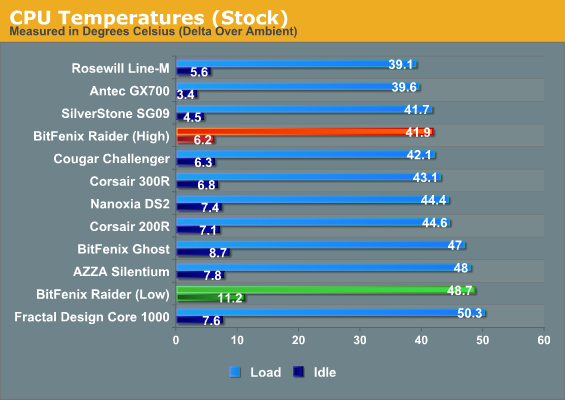
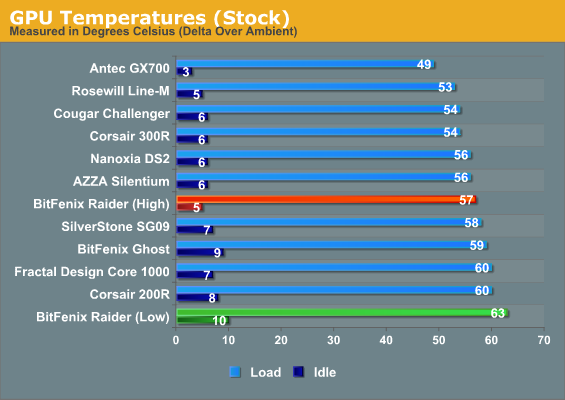
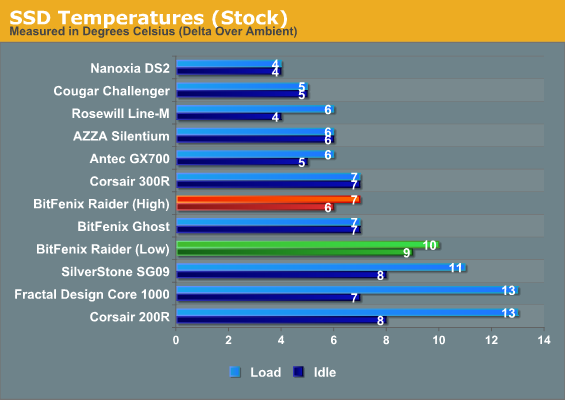
The Raider's low fan setting doesn't move a heck of a lot of air and the case puts in a mediocre showing as a result, but running the fans at full bore produces pretty competitive thermal results.
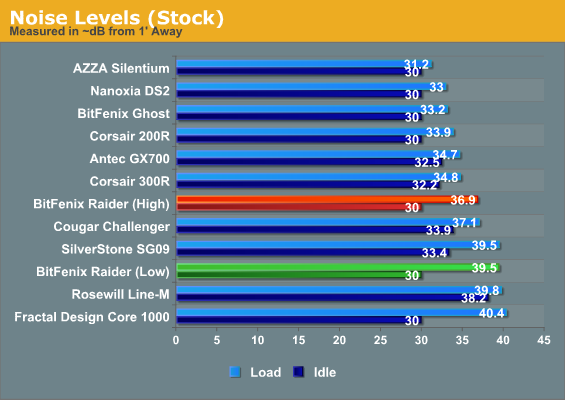
Despite all the hemming and hawing I do about fan controllers, the BitFenix Raider runs into the same "issue" Nanoxia's cases do: the fans included are so quiet and efficient on their own that cutting their speed is pointless. The Raider's Spectre fans are almost inaudible at their highest setting and produce far superior airflow, so there's no real reason to turn them down.
The Raider was able to produce competitive if not spectacular performance with our stock testbed, so naturally I was a little more curious to see how it would handle the increased thermal load of our overclocked bed.
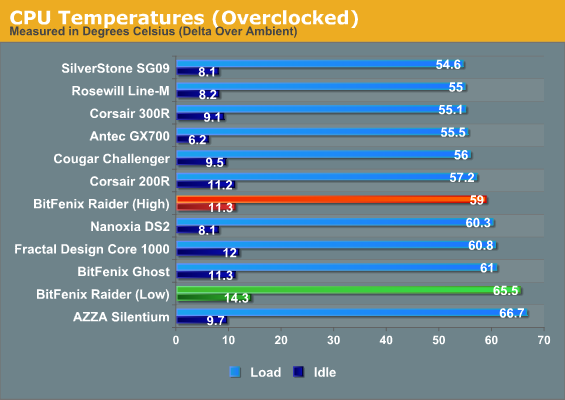
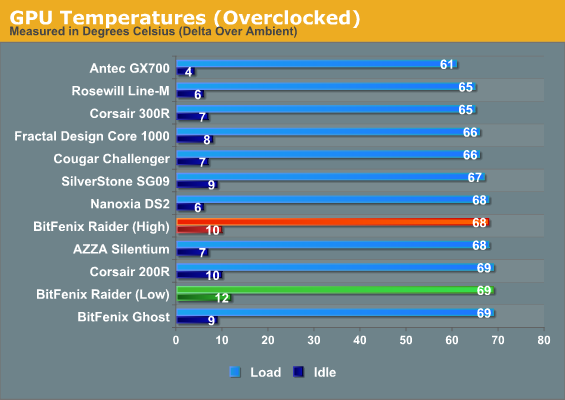
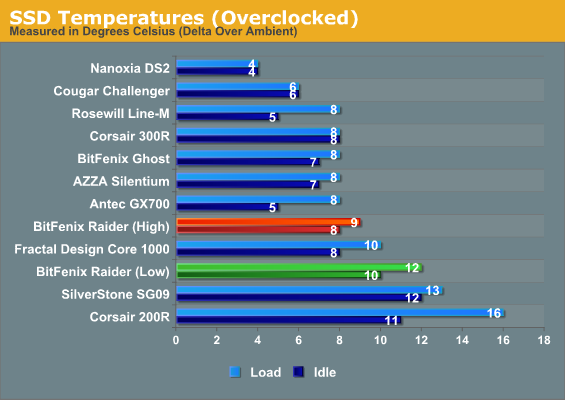
The Raider's not great, but it's still competitive if you ignore the low fan setting.
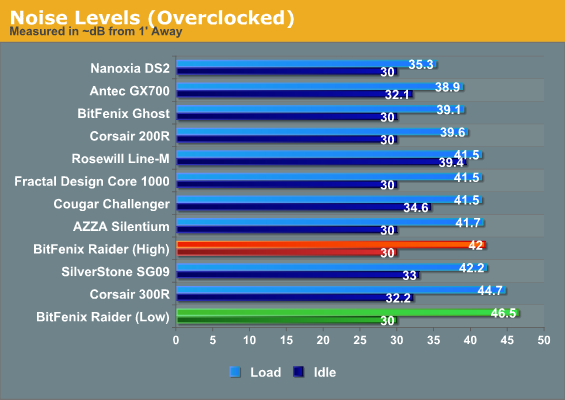
Once again, the "quieter" fan setting turns out to have the opposite effect, while the higher one produces noise results that are competitive without being exceptional.
Conclusion: Needs a Revision
The BitFenix Raider is a case I almost desperately want to like. I've had a personal, vested interest in BitFenix for a while now as a small manufacturer that produced some really great stuff, and I've wanted to make sure other people knew it. Their breakout product has probably been the Prodigy (which got picked up by almost every boutique under the sun), but really, they've had great stuff for a while now. I still think the Mercs are among the best budget cases money can buy.
BitFenix does a lot right with the Raider. However I feel about the case's quirks, you can't really deny it's a good-looking case, and it's pretty sturdy on top of that. The SECC steel used for the side panels is a little bit thin, but the rest of the body is very solid. Thermals and acoustics are both pretty middle of the road, and even though it's mostly useless in the stock configuration, I do appreciate the inclusion of a fan controller if for no other reason than that you won't have to add one later should you need it. The USB 2.0 headers coming out of the internal 3.0 headers are also a minor convenience I wish more manufacturers would include.
.jpg)
Where the Raider falls apart is when all the little details are taken together. What BitFenix really needs to do is take their baseline of this case and revise it. All the ideas are sound, but the execution has been fudged. Enlarge the cable routing holes, use twist ties on the included cable bundle (and route it through the tray closer to the top of the case to avoid blocking the top 5.25" bay), and loosen that bundle. Ship the thing with feet already installed that are bolted through the bottom of the shell. Allow for mounting a 240mm or 280mm radiator in the top of the case instead of just a 200mm fan, but include a pair of 200mm fans in the front and the top as well. The fan controller gives you an opportunity to choose between high performance and low noise, so take advantage of it with powerful fans.
Finally, there's the price tag. NewEgg currently has the Raider for $99, and at that price it's a bust, flat out. Users who want a more powerful case and don't mind mediocre build quality (or questionable aesthetics) will get their money's worth and then some from Antec's $59 GX700. When the Nanoxia Deep Silence 2 starts shipping stateside it'll eat the Raider alive at $99, offering good looks, good noise, and good performance. The $99 price tag is also within striking distance of Antec's devastating Eleven Hundred. There's one version of the Raider available for $79 on NewEgg right now, and that's really where the case ought to be at present.
There's potential for the Raider to be a great case, but BitFenix's designers need to take it back to the drawing board. Unless you're married to its looks (and admittedly I can understand that), there are better deals for better cases to be had elsewhere.

_thumb.jpg)
_thumb.jpg)
_thumb.jpg)
_thumb.jpg)
_thumb.jpg)
_thumb.jpg)
_thumb.jpg)
_thumb.jpg)
_thumb.jpg)
_thumb.jpg)
_thumb.jpg)
_thumb.jpg)






